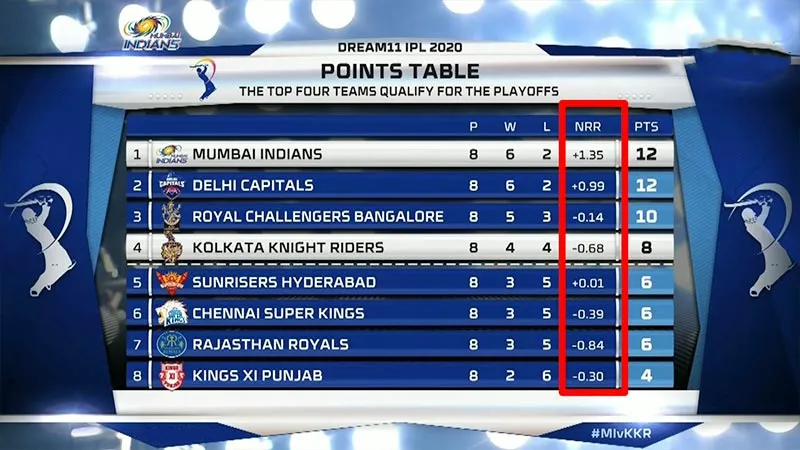One of the most common yet less understood abbreviations in cricket is NRR. You have probably seen it on your TV screen as well but have you ever wondered how NRR is calculated in Cricket?

Net Run Rate is a preferred statistical method that measures a cricket team’s performance against competing teams in a tournament. It is used in multi-team cricket tournaments for breaking ties.
So here is the formula for calculating Net Run Rate (NRR) in Cricket:

In simple terms, NRR is the runs scored by a team in a tournament divided by overs taken to score those runs subtracted by the total number of runs conceded by that team in the tournament divided by the total number of overs bowled.
But let’s not forget the exceptions and assumptions:
- NRR excludes abandoned/cancelled games (the DLS method takes over).
- If a team is all out well before the stipulated number of overs then the full quota of overs entitled to the team to bat is counted in the NRR calculation.
How is the Net Run Rate calculated? — An example
Let’s understand the NRR calculation with a hypothetical example.
Suppose India has scored following so far in the tournament:
| Against Australia | 255 runs (for 6 wkts) | From 47.2 overs |
| Against England | 200 runs (for 9 wkts) | From 50 overs |
| Against Pakistan | 226 runs (for 7 wkts) | From 50 overs |
In total, India scored 681 runs in a total of 147 overs and 2 balls, a rate of 681/147.334 = 4.622 rpo.
Example of Overs and Balls in Metric System: 147.1 Ov = 147.167 | 147.2 Ov. = 147.333 | 147.3 Ov. = 147.5 | 147.4 Ov.= 147.667 | 147.5 Ov.= 147.833 | 147.6 Ov. = 148
And the teams competing with India scored:
| Australia | 251 (for 5 wkts) | From 50 overs |
| England | 112 all out | From 35.2 overs |
| Pakistan | 102 all out | From 41 overs |
Now, let us remind you the exception we discussed above- If a team is all out well before the stipulated number of overs then the full quota of overs entitled to the team to bat is applied.
England and Pakistan were dismissed before the stippulated 50 overs, but the run rate is calculated as if they had scored the runs over the full 50 overs.
Therefore, the final run rate scored against India in the three games is calculated on the basis of 465 runs in a total of 50 + 50 + 50 = 150 overs, a rate of 465/150 or 3.1 rpo.
So the final Net Run Rate of India is: 4.622 — 3.1 = 1.522
How do you interpret NRR in a cricket tournament?
Here’s what you should understand — When a team is showing a positive NRR on the scoreboard; it means a team is scoring faster than its opposition. A negative NRR on the scoreboard indicates the team is scoring slower than the opposite teams hence, the NRR should be as high as possible.
FAQs about Net Run Rate and related terms
What is Run Rate?
Run rate is the average number of runs scored by a team in an innings. It is calculated by dividing the total runs scored by the team divided by the total overs bowled in an innings. The run rate is represented as RPO (runs per over).
Do wickets count in net run rate calculation?
No, wickets are not considered while calculating NRR. The total quota of overs is accounted for.
How to calculate the net run rate in a cricket tournament?
A team’s NRR is the average runs per over they score in the entire tournament minus the average runs per over scored against them.
How is the net run rate calculated in T20 cricket?
All T20 matches follow the same rule of net run rate calculation we discussed earlier. Only the number of overs is restricted to 20. In T20, players get the option of breaking ties in a super over awarded in the end.
How to calculate the net run rate or NRR in IPL?
IPL is a limited-over internationally recognized cricket tournament where the overs are restricted to 20 overs per innings. That’s the only difference. The rest of the NRR calculation for IPL matches is the same as any ODI or a Tri-series.
What is DLS or the Duckworth-Lewis-Stern method?
DLS is a topic that can be discussed in length in another article but its relation with NRR is important to note. The Duckworth–Lewis–Stern method (DLS) is a mathematical method to determine the target score (number of runs needed to win) for the team that bats second in a limited-overs cricket match that gets shortened due to rain or any other circumstances. The NRR method is used on completion of matches and DLS comes into the picture to calculate target scores and reach a preferable outcome in rain-shortened limited-overs matches.
So, what do you think? Is the NRR the right method to break ties? Is there a better way to end a tie in cricket?
Share your thoughts below in the comments section!
I am Dhaval Jain, SEO All-Rounder at CricHeroes.
CricHeroes is an ultimate Cricket Scoring App and the world’s only true Cricket Network. With more than 30 million registered cricketers using CricHeroes to Live Score their Local Cricket Matches and Tournaments, CricHeroes is already the number one Cricket Scoring App in the world!










